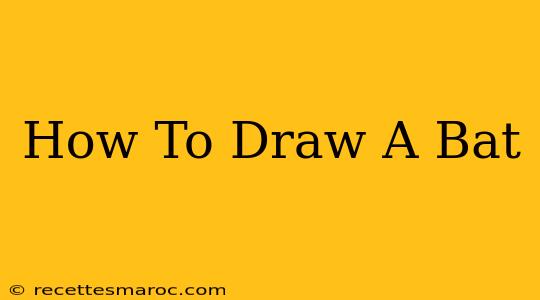Drawing a bat might seem intimidating, but with a little guidance, you can create a fantastic, fluttering friend on paper! This step-by-step guide will walk you through the process, whether you're a complete beginner or looking to refine your bat-drawing skills. We'll cover different styles, from simple cartoon bats to more realistic depictions. Get ready to unleash your inner artist!
Getting Started: Essential Materials
Before we begin our flight into the world of bat drawing, let's gather our essential materials:
- Paper: Any drawing paper will do, but thicker paper (like drawing pad paper) is preferable to prevent bleed-through, especially if you're using markers or watercolors.
- Pencil: A standard HB pencil is perfect for sketching. You can also use a 2B or 4B for darker lines and shading.
- Eraser: A good eraser is crucial for correcting mistakes and refining your drawing. A kneaded eraser offers more control.
- Optional Materials: Colored pencils, markers, crayons, or paints for adding color and detail to your finished bat.
Step-by-Step Guide to Drawing a Simple Cartoon Bat
This method is perfect for beginners and kids!
- The Head: Start with a simple circle for the bat's head.
- The Body: Add an elongated oval shape connected to the circle, forming the body.
- The Ears: Draw two small, pointed triangles on top of the head for the ears.
- The Wings: Draw two large, slightly curved lines extending from the body, creating the wings. These can be simplified as teardrop shapes.
- The Legs: Add two small, short lines underneath the body for the legs. They are often barely visible.
- The Face: Add two small circles for eyes and a small upside-down triangle for the mouth.
- The Details: Add some texture to the wings with small, curved lines to suggest the membrane.
Drawing a More Realistic Bat
This method involves more detail and shading.
- The Head: Begin with a slightly more elongated circle or oval for the head, considering the bat's snout.
- The Body: Attach a slender, tapering body to the head.
- The Wings: Draw the wings with more anatomical accuracy. Notice how the wings are attached to the body and the way they fold. Use reference images to help with this step! Sketch the wing membrane with subtle curves and folds.
- The Ears: Draw detailed, pointed ears with inner folds and textures.
- The Face: Add eyes, a nose, and mouth, paying attention to proportion and placement.
- The Legs and Feet: Draw the small legs and feet, often tucked up against the body. These are usually quite delicate.
- The Fur: Add texture by lightly sketching in short, fine lines to represent fur, especially around the head and body.
- Shading: Use shading to add depth and dimension to your drawing. Pay attention to where the light hits the bat and add darker tones in the shadowed areas.
Refining Your Bat Drawing Skills
- Use References: Look at real-life photographs or illustrations of bats to understand their anatomy and proportions.
- Practice Regularly: The more you practice, the better you'll become. Try drawing different types of bats.
- Experiment with Styles: Try different drawing styles, from realistic to cartoonish, to find what you enjoy most.
- Don't Be Afraid to Make Mistakes: Mistakes are part of the learning process. Embrace them and learn from them.
Different Types of Bats to Draw
There are many different types of bats! Try drawing these:
- Fruit Bats: Known for their larger size and fox-like faces.
- Vampire Bats: Smaller bats with a distinctive head shape.
- Brown Bats: Common bats found in many parts of the world.
Remember to have fun and let your creativity soar! With patience and practice, you'll be drawing amazing bats in no time.

